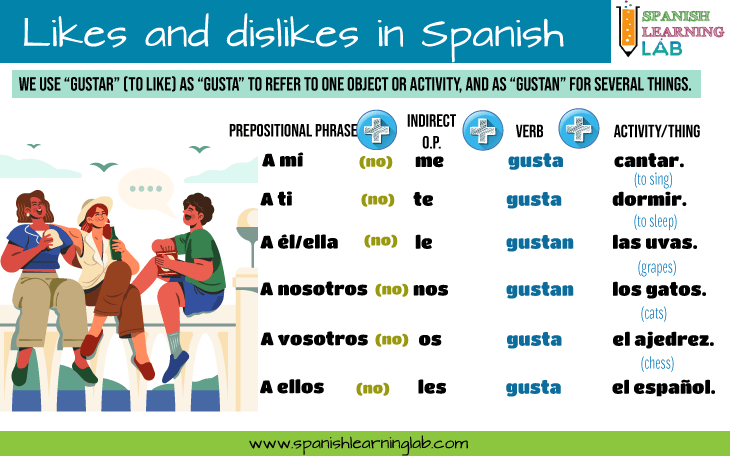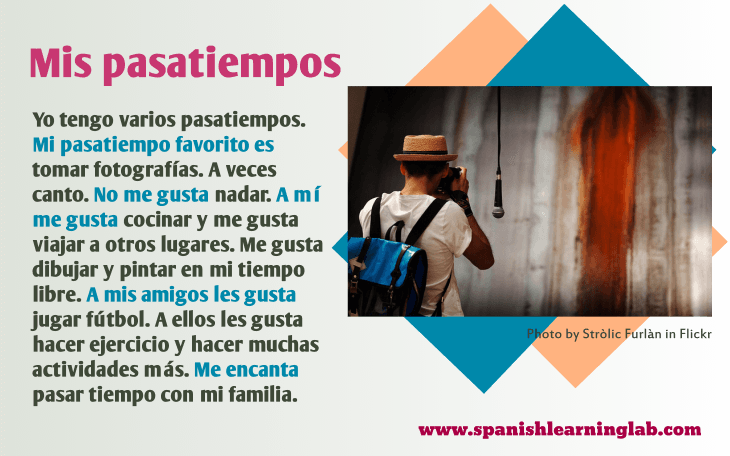LOS PASATIEMPOS or hobbies in Spanish are part of the vocabulary that is often used in conversations. In this lesson, we will review the most important vocabulary for hobbies with a short video and will focus on using this vocabulary for talking about likes and dislikes in Spanish using the verb GUSTAR and few other similar verbs. More than plain vocabulary lists, this lesson will teach how to make sentences with a list of activities in Spanish and give you a chance to practice listening too. Comencemos…
Vocabulary review: A List of Hobbies in Spanish
First of all, the video below will introduce a list of hobbies in Spanish and common activities that most people like to do through basic sentences. The video also explains a little about the way to express likes and dislikes in Spanish, something that we will be covering with more details in the rest of the lesson. If you need the translation, please activate the subtitles (cc) below.
Expressing Likes and Dislikes in Spanish with GUSTAR
Saying what you like in Spanish
First, let’s talk about expressing likes and dislikes in Spanish with “GUSTAR”. This verb is frequently accompanied by an indirect object pronoun (me, te, nos, os, le) and sometimes by a prepositional phrase like “A mí…”. Both help us know who likes an activity in Spanish. For example, “I like soccer” would be translated properly into “A mí me gusta el fútbol“, where A MÍ (to me) is an optional prepositional phrase, ME is the corresponding indirect object pronoun for YO and GUSTA is one of the forms of GUSTAR.

The verb GUSTAR will be conjugated as GUSTA to express likes and dislikes in Spanish, particularly activities as they are uncountable nouns, .e.g “A ti te gusta ver televisión“. However, it will be conjugated as GUSTAN when referring to several physical objects, but not activities in Spanish, for example: “Me gustan las fotos“(I like the photos). Likewise, you can use other verbs for talking about likes and dislikes in Spanish such as: ENCANTAR (to love), EMOCIONAR (to feel excited) and ALEGRAR (to make happy). ENCANTAR, just like GUSTAR, will change to ENCANTA as in “Me encanta hacer ejercicio”, EMOCIONAR to EMOCIONA as in “A ella le emociona viajar” and ALEGRAR to ALEGRA.
How to conjugate GUSTAR in Spanish in the present tense
As you may notice, knowing what prepositional phrase or pronoun to use may be difficult, which is why we prepared a simple chart showing how to conjugate GUSTAR. These conjugations will be complemented with a list of Spanish activities for hobbies to make complete sentences. The subject pronouns in the chart will work only as a reference so you should leave them out when making sentences about likes and dislikes in Spanish. On the other hand, prepositional phrases like “A mí” can be added or omitted without any change in meaning, e.g. “(A mí) Me gusta tocar guitarra“.
| Subject | Prep. phrase | IO pronoun | GUSTAR | hobbies in Spanish |
|---|---|---|---|---|
| Yo | A mí | me | gusta | tocar guitarra |
| Tú | A ti | te | gusta | mirar televisión |
| Él | A él | le | gusta | cantar |
| Ella | A ella | le | gusta | bailar |
| Usted | A usted | le | gusta | hacer ejercicio |
| Nosotros | A nosotros | nos | gusta | cocinar |
| Vosotros | A vosotros | os | gusta | pintar |
| Ellos | A ellos | les | gusta | tomar fotos |
Sentences with a list of activities in Spanish plus likes and dislikes
Me gusta + a list of activities in Spanish
In this section, we will show you several examples of sentences using a list of activities in Spanish for hobbies and ways to express likes and dislikes. Pay attention how the verb GUSTAR is conjugated and used in each example, and more importantly, identify the main activities in Spanish people are talking about. Use the chart above and the translation to find out other hidden details.
|
A ella le gusta leer libros de misterio.
She likes reading mistery books
|
|
Me gusta leer el periódico todos los días.
I like reading the newspaper every day
|
|
Nos gusta tocar guitarra.
Playing the guitar/ piano -We like playing guitar
|
|
Bailar / El baile – A mí me gusta bailar ¿y a ti?
To dance/ Dancing – I like dancing, what about you?
|
|
Dibujar / El dibujo – A mí me gusta mucho el dibujo
To draw/Drawing – I like drawing a lot
|
|
Relajarse – Me gusta relajarme escuchando música.
Relaxing – I like relaxing listening to music
|
|
Pintar / La pintura – Parece que te gusta la pintura.
To paint/Painting – It seems you like painting
|
Asking about hobbies in Spanish and expressing dislikes
In order to ask about the hobbies that another person likes to do in Spanish, you can use simple SI/NO questions like ¿Te gusta + hobby or hobbies in Spanish?. Most likely, the answer to this question will follow the structure of the sentences above. As for expressing dislikes in Spanish, you simply need to place the word NO before the direct object pronoun e.g. “NO me gusta cantar” and “(A mí) No me gusta leer libros”. Here are some examples asking about hobbies in Spanish.
|
¿Te gusta nadar? – Si
Do you like swimming? – Yes
|
|
Cantar / El canto – ¿Te gusta cantar baladas? – A veces
To sing/ Singing – Do you like singing romantic music? – Sometimes
|
|
Tomar fotos – ¿A ustedes les gusta tomar fotos? – A nosotros sí.
Taking pictures – Do you like taking pictures? – We do
|
|
Cocinar/La cocina – ¿Te gusta cocinar comidas extranjeras?
To cook/Cooking – Do you like cooking foreign food?
|
A bit about prepositional pronouns in Spanish
Expresions like “A mí” (to me) and “A ti” are prepositional phrases that comes from joining the preposition “A” and a prepositional pronoun. “A mí” tells us that the person is talking about himself, so it should preceed the structure “me gusta” (which refers to onself), e.g. “A mí me gusta el fútbol”. When you hear a question using the prepositional phrase “a ustedes”, you must answer with the prepositional phase “a nosotros”. Remember that “nos” belongs to “nosotros”, “me” to “mi” and so on. Know that these prepositional phrases are optional, but they are still very useful to stress who likes or dislikes an activity in Spanish.
My favorite hobbies in Spanish – Mis pasatiempos
Now we will see an example using the sentence structure we covered in the previous lesson and all the things we have explained so far. This paragraph is about a guy saying what hobbies in Spanish he likes and dislikes, as well as a list of activities in Spanish that his friends like too.

Listening Activity: Talking about hobbies in Spanish
Key phrases in the conversation:
- ¡Qué interesante! means that’s interesting
- En realidad means actually
Writing: My favorite hobbies in Spanish
Well, we are almost done with the lesson, so let’s wrap up everything. Some key expressions we have seen are [Mi pasatiempo favorito es + pasatiempo] and [En mi tiempo libre me gusta + actividades]. GUSTAR is used for likes and dislikes in Spanish. In future lessons, we will study the vocabulary for sports in Spanish and popular movie genres in Spanish. We truly hope you found this lesson usefu!
Interactive quiz: Likes and dislikes in Spanish
Homework
Write a paragraph about your favorite hobbies in Spanish- “tus pasatiempos favoritos”. You can add information about your family’s hobbies if you want. A good way to improve your pronunciation is recording yourself and comparing what you say to the examples provided in the lesson.
Related Spanish Worksheets:
- Common Hobbies in Spanish
- Pastimes, Likes & Dislikes in Spanish
- The Verb GUSTAR in Spanish (Chart + Sentences)
- Common Sports in Spanish
- My Favorite Hobbies in Spanish – Reading Worksheet
- Let’s talk about Favorites in Spanish – Conversation cards
- Likes and Preferences in Spanish – Conversation cards

ME ENCANTA TU PAGINA!
Muchas gracias. Nos alegra que te guste. ¡Saludos!